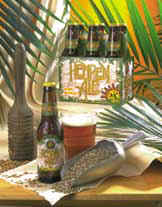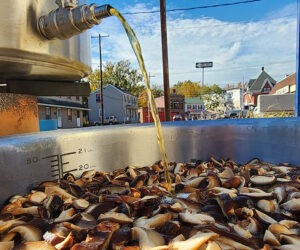Brewing Hempen Ale
Frederick Brewing Co. was not necessarily pioneering brewing with hemp, just doing it legally. Over the years hemp has made its way into a few brews. An early attempt was made in the 1960s at an underground brewery on the island of Oahu, Hawaii. The brewers produced an oil from the leaves and blossoms of marijuana plants and added it to the beer, rumored to have sold illegally for as much as $45 per case. Another brewer began brewing Hi-Brew in 1979 using the leaves and trimmings of the marijuana plant to “dry hemp” — like dry hop — the beer prior to bottling. Obviously, neither of these strategies would hold up in the real world of the ATF, FDA, DEA, and the rest of the acronym agencies.
Hemp is a fabulous natural resource, and when I began doing some research on how I could incorporate it into the brewhouse, using the seeds as a portion of the grain bill in the mash became an obvious choice. Hemp seeds are a grain of sorts, like oats, rye, and barley, all of which have found their way into other recipes here at Frederick Brewing Co.
However, being a very close relative to marijuana, industrial hemp does still contain minimal quantities of THC (tetrahydrocannabinol), the active ingredient in marijuana. This makes it a controlled substance and illegal to cultivate in the United States. The hemp seeds imported into the United States must be sterilized to render them nonviable. Although the seeds themselves do not contain any traceable THC, planting them produces a plant that contains THC. In fact the seeds must be thoroughly cleaned and free of virtually all — in government speak — “extraneous vegetative material.” When the seeds are harvested, a bit of the leafy greens generally ends up among the seeds. If this is not properly cleaned out, traceable quantities of THC can exist in the seeds. This has never been a problem with Hempen Ale and Hempen Gold since our seeds are always thoroughly cleaned and THC is not water soluble, so it won’t carry forward into the finished product.
I still remember quite vividly the first phone calls when I began the search for hemp seed. The first person laughed and referred me to another, who chuckled and referred me to another. This continued for a dozen calls over many days, but eventually the guy who laughed the loudest and the longest sent me a 50-pound bag free of charge. It turned out to be a pretty good speculation, since we have purchased more than 200,000 pounds of seed from his company over the last few years.
Preparation
During my first attempt at a pilot batch, I wanted to lightly roast the seeds to get a nice character. I took about 15 pounds of seed to a local coffee shop that has a small roaster. Once convinced that she was not going to be arrested for her efforts, the owner was more than willing to help in the quest. The seeds were roasted at 450° F, and I took about three pounds out every minute to get some varying degrees of color and character. The last few pounds that came out of the roaster were not particularly dark, but a few had exploded like popcorn. This all sounded like a great plan until we had to try to cool and separate what had become five different batches of 450° F seeds. The whole process was not exactly OSHA friendly, but I got what I was looking for.
In formulating a product like this, I wanted to make sure that the hemp could be used in a significant proportion to make a legitimate contribution to the character of the beer. We were prepared for the fact that many people would be looking to tear the product apart, claiming every reason to cry “gimmick.” We did not want them to infer that we were just waving a few hemp seeds over the kettle so we could say it was brewed with hemp. I never even attempted to determine what the minimum proportion of hemp would be; I actually started with the maximum amount I thought we could realistically use and backed up from there.
Experimenting
The varying degrees of roasting did not yield much variation in color, and there was very little overall difference in the seeds that were removed after one, two, and three minutes. The seeds that roasted four and five minutes were almost too acrid to use. The first dozen five-gallon pilot batches focused on using the seeds from the first three minutes in proportions varying from 15 percent to 40 percent. We also brewed a batch with no hemp at all for comparison.
Because the primary focus at this point was to discover what the hemp was contributing to the wort, I used a single hop variety contributing 15 to 20 bitterness units. The results of the first batches of Hempen Ale were very exciting to say the least. There was a pleasing nutty character and a nice thick and creamy character from the seed, which has a protein content of nearly 33 percent. However, the brews with more than 20 percent hemp did not end up with enough malt character and got a little oily on the palate.
Once I determined that there was definitely an interesting character and flavor contribution from the hemp, a couple of our other brewers and I began to put the finishing touches on the recipe. We were aiming for a finished product with a floral hop character to complement the earthy qualities of the hemp. After a few pilot brews using what we had determined to be the ideal grain bill and changing the hop variety and target bitterness units, we really enjoyed the qualities of Cascade hops. We decided to use them from kettle to whirlpool.
Big Batches
Having finalized what we thought was the perfect formulation for Hempen Ale, we began the difficult task of trying to acquire, handle, and roast the thousands of pounds of seed we would require to produce at a commercial level. We were just relocating to a new facility and would be brewing in 50-barrel batches (1,550 gallons). Sales projections were calling for at least 600 barrels (18,600 gallons) of beer necessary for the product rollout. It was becoming painfully obvious that using roasted seed would be a huge logistical problem.
I met with two regional coffee companies about doing some contract roasting, but their equipment was not able to handle the small size of the hemp seeds. I even had a meeting with a barley malting company about the feasibility of the company roasting and handling the seeds for us. However, after a few tests the company had to decline due to the possibility of cross-contamination of the hemp seed into their products. We went back to the drawing board and many pilot brews later, we had formulated a new version of Hempen Ale. It was brewed using raw seed that had been prepared for us by another company. The product was very similar to the original and the raw seed contributed a good hemp quality to the beer, but I was a little disappointed. I saw it as a compromise to the product I had originally developed. Still, I was very anxious to begin production on what we all knew would be an exciting and controversial beer.
First Out
The motivation behind spending years of research and development and many thousands of dollars in attorneys’ fees to make these products and get the label approval was tremendous. We had the excitement of blazing the trail, a chance to shake up the brewing industry a little, and the desire to prove all the “you can’t do that” people wrong. But if we were going to do this product, we were going to do it right.
All of these concerns were put to rest with the bronze metal Hempen Ale received at the 1997 Great American Beer Festival in the herb/spice category. Since then many other breweries have jumped on the bandwagon with hemp beers of their own. Imitation is the sincerest form of flattery — right?




